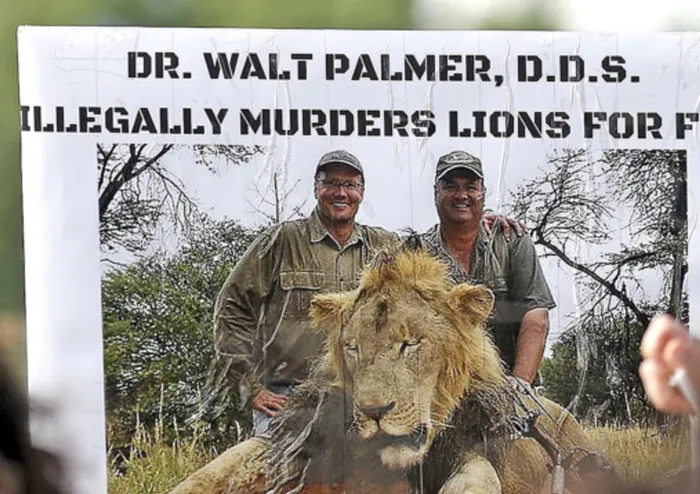US law to muzzle lion hunting

Protesters hold signs during a rally outside the River Bluff Dental clinic against the killing of a famous lion in Zimbabwe, in Bloomington, Minnesota July 29, 2015. Wildlife officials on Tuesday accused American hunter Walter Palmer of killing Cecil, one of the oldest and most famous lions in Zimbabwe, without a permit after paying $50,000 to two people who lured the beast to its death. As of Tuesday, Palmer had temporarily closed his office, River Bluff Dental, in Bloomington, Minnesota, amid wishes for his death and widespread criticism of his hunting on social media and under business reviews on Google and Yelp. REUTERS/Eric Miller Protesters hold signs during a rally outside the River Bluff Dental clinic against the killing of a famous lion in Zimbabwe, in Bloomington, Minnesota July 29, 2015. Wildlife officials on Tuesday accused American hunter Walter Palmer of killing Cecil, one of the oldest and most famous lions in Zimbabwe, without a permit after paying $50,000 to two people who lured the beast to its death. As of Tuesday, Palmer had temporarily closed his office, River Bluff Dental, in Bloomington, Minnesota, amid wishes for his death and widespread criticism of his hunting on social media and under business reviews on Google and Yelp. REUTERS/Eric Miller
Cape Town - The Humane Society of the US have claimed a major victory after the US government decided to list two sub-species of lions as endangered and threatened under the US Endangered Species Act.
The listing automatically bans the trade in these animals or their body parts and would prevent American hunters from bringing home trophies they had hunted.
The Humane Society of the US said it believed the move would put a major dent in the so-called “canned lion” hunting industry in South Africa.
In response to the dramatic decline of lion populations in the wild, Panthera leo leo lions located in western and central Africa and India, were to be listed as endangered, and Panthera leo melanochaita lions, located in eastern and southern Africa, would be listed as threatened, the US Fish and Wildlife Service (USFWS) announced in a news release this week.
The steps were taken five months after the notorious killing of “Cecil”, a star lion that was a tourist attraction in Hwange National Park in Zimbabwe, by Walter Palmer, a US dentist in the state of Minnesota.
The killing sparked widespread anger and protests at big-game trophy hunting in Africa, though Palmer was cleared of wrongdoing by Zimbabwean authorities who said he did not break the law.
Concurrent with this listing rule, USFWS director Dan Ashe issued an order to strengthen enforcement of wildlife permitting requirements “to protect lions and other foreign and domestic wildlife from criminal activity”.
Under the order, American violators of wildlife laws will not be granted permits for future wildlife-related activities, including the import of sport-hunted trophies.
There are only about 1 400 of the Pl leo lions remaining, including 900 in Africa and 523 in India.
With the endangered listing, imports of the Pl leo lions will generally be prohibited, except in certain cases, such as when it can be found that the import will enhance the survival of the species.
The numbers of the Pl melanochaita lions are estimated at between 17 000-19 000 across southern and eastern Africa. The USFWS determined that this subspecies, which is less vulnerable and not currently in danger of extinction, meets the definition of a threatened species under the ESA.
The agency is finalising a rule under the ESA to establish a permitting mechanism regulating the import of all Pl melanochaita parts and products into the US to ensure that they are legally obtained in countries as part of a scientifically sound management programme that benefits the subspecies in the wild.
Permits would also be required for scientific purposes, activities that enhance the propagation or survival of the subspecies in the wild, zoological exhibitions, educational purposes or other ESA related purposes.
The USFWS is also working to increase the fees it charges for these permit applications.
“The lion is one of the planet’s most beloved species and an irreplaceable part of our shared global heritage,” said Ashe.
“If we want to ensure that healthy lion populations continue to roam the African savannas and forests of India, it’s up to all of us – not just the people of Africa and India – to take action.”
The Humane Society said South African canned hunting breeders often claimed their activities were helping to conserve the species in the wild, but there was no proof of this. They were now under obligation to prove it.
“American trophy hunters are directly responsible for slaughtering at least 5 647 lions in the last 10 years, according to USFWS import data compiled by The Humane Society of the US and Humane Society International, which joined other organisations to petition the agency to protect lions,” said Wayne Pacelle, president and chief executive of The HSUS. “
“This US action should end the free-for-all for Americans who wish to kill these animals and import them through our ports just for a head-hunting exercise.
“More than half of the lion trophies imported to the US in 2014 came from South Africa’s canned hunts, where wealthy fat cats shoot down endangered big cats trapped behind fences and unable to escape.”
The society claimed of the 719 lions whose parts were imported to the US in 2014, 620 were imported from South Africa and 370 (or 51 percent) were killed in that country’s captive lion hunts.
Other import data from last year are: 42 from Zimbabwe, 40 from Tanzania, 10 from Mozambique, three from Namibia, two from Burkina Faso and one each from Benin and Cameron.
Cape Argus